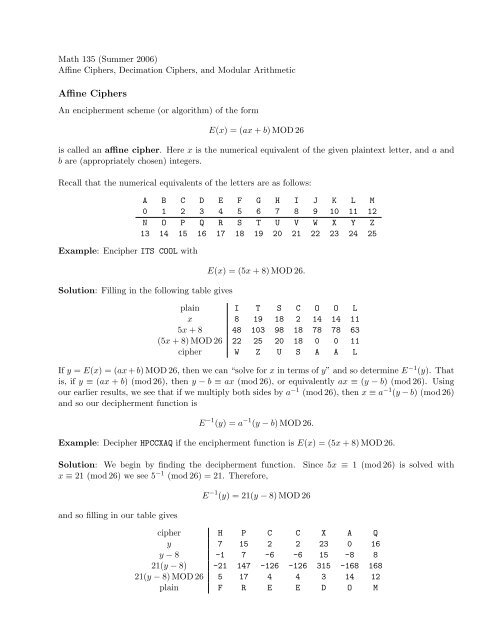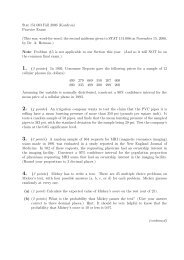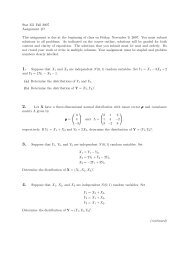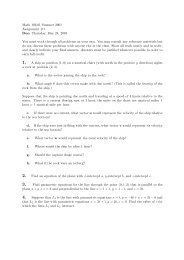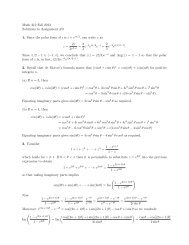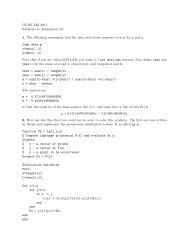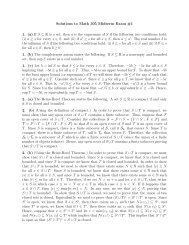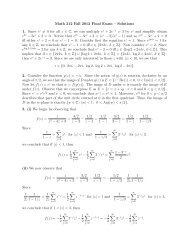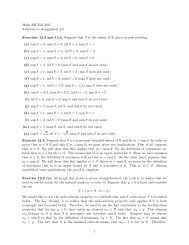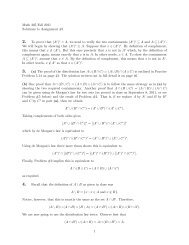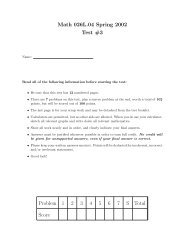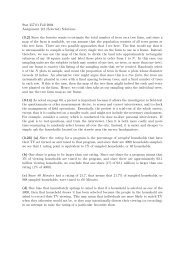Affine Ciphers
Affine Ciphers
Affine Ciphers
Create successful ePaper yourself
Turn your PDF publications into a flip-book with our unique Google optimized e-Paper software.
Math 135 (Summer 2006)<strong>Affine</strong> <strong>Ciphers</strong>, Decimation <strong>Ciphers</strong>, and Modular Arithmetic<strong>Affine</strong> <strong>Ciphers</strong>An encipherment scheme (or algorithm) of the formE(x) = (ax + b) MOD 26is called an affine cipher. Here x is the numerical equivalent of the given plaintext letter, and a andb are (appropriately chosen) integers.Recall that the numerical equivalents of the letters are as follows:Example: Encipher ITS COOL withA B C D E F G H I J K L M0 1 2 3 4 5 6 7 8 9 10 11 12N O P Q R S T U V W X Y Z13 14 15 16 17 18 19 20 21 22 23 24 25Solution: Filling in the following table givesE(x) = (5x + 8) MOD 26.plain I T S C O O Lx 8 19 18 2 14 14 115x + 8 48 103 98 18 78 78 63(5x + 8) MOD 26 22 25 20 18 0 0 11cipher W Z U S A A LIf y = E(x) = (ax + b) MOD 26, then we can “solve for x in terms of y” and so determine E −1 (y). Thatis, if y ≡ (ax + b) (mod 26), then y − b ≡ ax (mod 26), or equivalently ax ≡ (y − b) (mod 26). Usingour earlier results, we see that if we multiply both sides by a −1 (mod 26), then x ≡ a −1 (y − b) (mod 26)and so our decipherment function isE −1 (y) = a −1 (y − b) MOD 26.Example: Decipher HPCCXAQ if the encipherment function is E(x) = (5x + 8) MOD 26.Solution: We begin by finding the decipherment function.x ≡ 21 (mod 26) we see 5 −1 (mod 26) = 21. Therefore,Since 5x ≡ 1 (mod 26) is solved withE −1 (y) = 21(y − 8) MOD 26and so filling in our table givescipher H P C C X A Qy 7 15 2 2 23 0 16y − 8 -1 7 -6 -6 15 -8 821(y − 8) -21 147 -126 -126 315 -168 16821(y − 8) MOD 26 5 17 4 4 3 14 12plain F R E E D O M
Example: Suppose that an affine cipher E(x) = (ax + b) MOD 26 enciphers H as X and Q as Y. Findthe cipher (that is, determine a and b).Solution: We see thatThat is,H ↦→ X means E(7) = 23 and Q ↦→ Y means E(16) = 24.a · 7 + b ≡ 23 (mod 26) and a · 16 + b ≡ 24 (mod 26).Subtracting gives 16a − 7a ≡ 1 (mod 26) so that 9a ≡ 1 (mod 26). Therefore, a = 9 −1 (mod 26) = 3.Finally, we substitute a = 3 into either of the earlier equations and solve for b,In summary,i.e., 3 · 7 + b ≡ 23 (mod 26) implies b = 2.E(x) = (3x + 2) MOD 26.Remark: (The “Mod-mod Connection”)The least non-negative solution of the congruence x ≡ b (mod m) is x = b MOD m.Decimation <strong>Ciphers</strong>In the special case where b = 0, the affine cipher E(x) = ax MOD m is called a decimation cipher.This is discussed in detail on pages 70–73. The key idea in this subsection is that certain choices of aand m do not lead to valid substitutions.Example: Suppose that E(x) = 4x MOD 26. Determine the ciphertext alphabet.Solution: We begin with our table of numerical equivalents, and then determine 4x MOD 26.plain A B C D E F G H I J K L M N O P Q R S T U V W X Y Zx 0 1 2 3 4 5 6 7 8 9 10 11 12 13 14 15 16 17 18 19 20 21 22 23 24 254x 0 4 8 12 16 20 24 28 32 36 40 44 48 52 56 60 64 68 72 76 80 84 88 92 96 1004x MOD 26 0 4 8 12 16 20 24 2 6 10 14 18 22 0 4 8 12 16 20 24 2 6 10 14 18 22cipher A E I M Q U Y C G K O S W A E I M Q U Y C G K O S WThe problem, of course, is that 4 and 26 are not relatively prime, and so this cyclic phenomenon occursin the cipher alphabet. Since the numbers 0, 2, 4, 6, 8, 10, 12, 13, 14, 16, 18, 20, 22, 24 are not relativelyprime with respect to the 26, the only possible choices for the decimation cipher E(x) = ax MOD 26are a = 1, 3, 5, 7, 9, 11, 15, 17, 19, 21, 23, 25. Therefore, we conclude that the decimation cipher is weakerthan the simple shift cipher. If the cryptanalyst knows that a shift cipher has been used, then there are25 possible shifts that need to be checked. However, if it is known that a decimation cipher has beenused, then there are only 12 possible ciphers that need to be checked.Summary of Valid <strong>Affine</strong> <strong>Ciphers</strong>The function E(x) = (ax + b) MOD 26 defines a valid affine cipher if a is relatively prime to 26, and bis an integer between 0 and 25, inclusive. If b = 0, then we refer to this cipher as a decimation cipher.(Note that since there are 12 valid choices of a and 26 valid choices of b, there are 12×26 = 312 possiblevalid affine ciphers.)Also note that if a = 1, then E(x) = (x + b) MOD 26 is simply a Caesar (+b) shift cipher.


